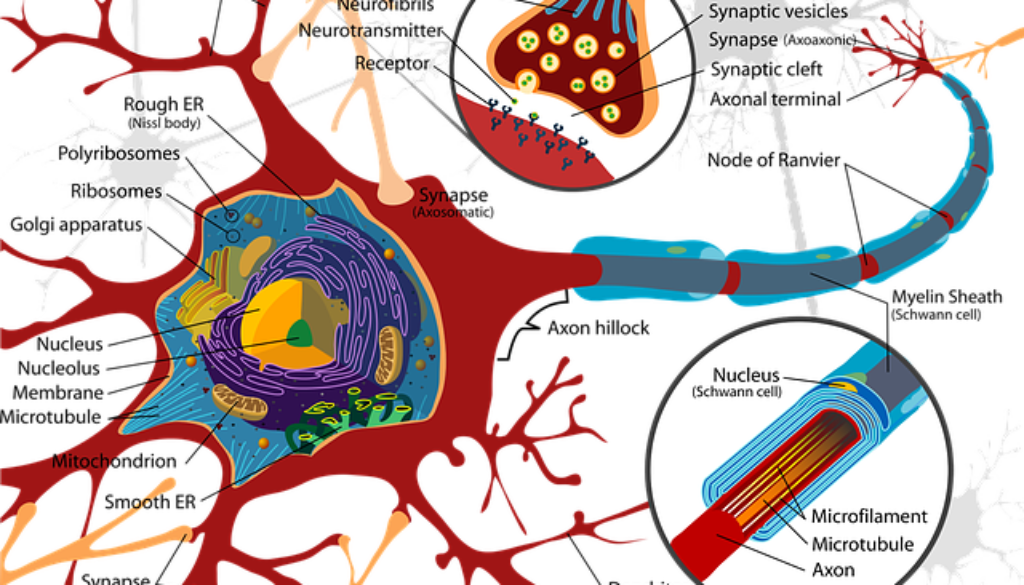NERVE ANATOMY ? FREQUENCY ~ VIBRATION “SHABDA” CELLULAR AWARENESS
CELLULAR AWARENESS ~ “I AM”
?
NERVES
Nervous Tissue
The majority of the nervous system is tissue made up of two classes of cells: neurons and neuroglia.
Neurons
Neurons, also known as nerve cells, communicate within the body by transmitting electrochemical signals. Neurons look quite different from other cells in the body due to the many long cellular processes that extend from their central cell body. The cell body is the roughly round part of a neuron that contains the nucleus, mitochondria, and most of the cellular organelles. Small tree-like structures called dendrites extend from the cell body to pick up stimuli from the environment, other neurons, or sensory receptor cells. Long transmitting processes called axons extend from the cell body to send signals onward to other neurons or effector cells in the body.
There are 3 basic classes of neurons: afferent neurons, efferent neurons, and interneurons.
- Afferent neurons. Also known as sensory neurons, afferent neurons transmit sensory signals to the central nervous system from receptors in the body.
- Efferent neurons. Also known as motor neurons, efferent neurons transmit signals from the central nervous system to effectors in the body such as muscles and glands.
- Interneurons. Interneurons form complex networks within the central nervous system to integrate the information received from afferent neurons and to direct the function of the body through efferent neurons.
Neuroglia
Neuroglia, also known as glial cells, act as the “helper” cells of the nervous system. Each neuron in the body is surrounded by anywhere from 6 to 60 neuroglia that protect, feed, and insulate the neuron. Because neurons are extremely specialized cells that are essential to body function and almost never reproduce, neuroglia are vital to maintaining a functional nervous system.
Nerves
Nerves are bundles of axons in the peripheral nervous system (PNS) that act as information highways to carry signals between the brain and spinal cord and the rest of the body. Each axon is wrapped in a connective tissue sheath called the endoneurium. Individual axons of the nerve are bundled into groups of axons called fascicles, wrapped in a sheath of connective tissue called the perineurium. Finally, many fascicles are wrapped together in another layer of connective tissue called the epineurium to form a whole nerve. The wrapping of nerves with connective tissue helps to protect the axons and to increase the speed of their communication within the body.
- Afferent, Efferent, and Mixed Nerves. Some of the nerves in the body are specialized for carrying information in only one direction, similar to a one-way street. Nerves that carry information from sensory receptors to the central nervous system only are called afferent nerves. Other neurons, known as efferent nerves, carry signals only from the central nervous system to effectors such as muscles and glands. Finally, some nerves are mixed nerves that contain both afferent and efferent axons. Mixed nerves function like 2-way streets where afferent axons act as lanes heading toward the central nervous system and efferent axons act as lanes heading away from the central nervous system.
- Cranial Nerves. Extending from the inferior side of the brain are 12 pairs of cranial nerves. Each cranial nerve pair is identified by a Roman numeral 1 to 12 based upon its location along the anterior-posterior axis of the brain. Each nerve also has a descriptive name (e.g. olfactory, optic, etc.) that identifies its function or location. The cranial nerves provide a direct connection to the brain for the special sense organs, muscles of the head, neck, and shoulders, the heart, and the GI tract.
- Spinal Nerves. Extending from the left and right sides of the spinal cord are 31 pairs of spinal nerves. The spinal nerves are mixed nerves that carry both sensory and motor signals between the spinal cord and specific regions of the body. The 31 spinal nerves are split into 5 groups named for the 5 regions of the vertebral column. Thus, there are 8 pairs of cervical nerves, 12 pairs of thoracic nerves, 5 pairs of lumbar nerves, 5 pairs of sacral nerves, and 1 pair of coccygeal nerves. Each spinal nerve exits from the spinal cord through the intervertebral foramen between a pair of vertebrae or between the C1 vertebra and the occipital bone of the skull. (innerbody.com)



